This is amazing to see:
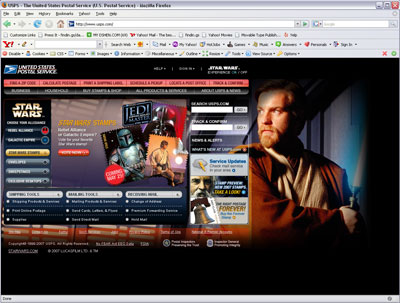
Visit usps.gov – Enlarge image
When I started working on online ads, it was acknowledged that c|net.com was one of the most innovative in online advertising. Then came the portals, and pushed by all the advertising technology companies like Eyeblaster.com and Pointroll.com. We’d all be doing floating ads and site takeovers, popups and popunders, expanding ads, video ads and wondering what our users were thinking about all these things flying around on their pages.
However, it was only those companies that were innovative and daring enough, and desperate enough for revenue, that would try these ideas. Some worked, some didn’t. But pretty much everything generated revenue. Some of the older institutions would never try these ideas. They worried about annoying users or creating experiences that would degrade trust of their users. For the most part, they were right. But sometimes we found they were wrong.
It’s hard to predict what users think. The world keeps changing and users’ preferences and tolerances change as the internet presents experiences that, in the beginning, are unique and potentially shocking, but then over time become commonplace.
What does this say about the internet when a venerable organization such as the United States Post Office joins the online advertising revolution-now-become-commonplace and places a site takeover on their top page?
Category Archives: Internet/Online
The Pesky Blogosphere
Recently, when you search on David Shen Ventures on Google or Yahoo!, I come up on some other blogs now.
If you know how blogs seem to work these days, there is a lot of rehashing of content to create content. Bloggers follow other sources and then paraphrase, rewrite, or add onto the content by commenting on it. It’s an easy way to generate material for articles, versus coming up with something yourself.
But sometimes, they get it totally wrong. It’s a problem with citizen journalism. Professional journalists have methods of working and standards to uphold (at least most of them anyways). One big characteristic is truth in journalism, and the verification of facts before publishing something so as to maintain/increase reader trust, which is a good way to get readers to come back and read your stuff.
Today’s new citizen journalists often don’t have these standards. Nobody taught them how to be like professional journalists. They just started writing and sometimes are unaware of things like holding high ethics and standards. They have different motivations like creating content which generates traffic which generates revenue through ads and affiliate programs.
So now I’ve been mentioned by some citizen bloggers, who I am sure are just trying to create content by following activity on my companies page. Unfortunately, the information is wrong. They say I have invested in a bunch of companies but it is not true. Even though a company is mentioned on my companies page, it does not mean I have invested in it. My model is to be advisor to every company listed, but I could be advising without investing.
None of them have taken the time to verify the information. They just made some assumptions and posted them.
Think what would happen if reporters on CNN reported this way. How would you feel about their news? Still trust it?
Junk Filter Hell: Outlook is Simply Ridiculous
OK so I’ve been complaining about Yahoo! Mail Spam filtering for a while now because it’s catching so many important emails from people I want to get email from. I try to add people to my address book as fast as possible, but often I don’t get them there fast enough. I just grin and bear it; it’s better than receiving 1000+ spam emails but missing that one super important one isn’t a good thing.
But today, my Outlook’s Junk Filter started JUNKING EMAIL FROM MYSELF. Is that ridiculous or what?
This is why Microsoft will never produce products as cool as Apple’s, or win in the long run.
I Need MOOOOO Therapy
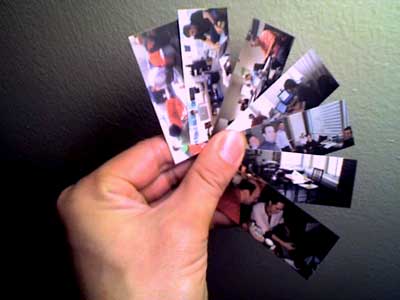
These Moo cards are really starting to take my brain and feelings for a loop.
The impulse to make more is staggering. It takes a huge force of will to not go and upload more pics and order more.
When I order them, my intent is to use them as a personal ID card or as a unique business card design. But I find that when I get them, it is super hard to part with them. I like them so much that it’s hard for me to give them away! I think it’s the fact that I took those pics on the backs. I have a deep attachment to them simply for that fact alone.
It’s also their novelty and size. The slender aspect ratio of these cards makes them almost cute and you want to own them. I can’t part with them because they are so keep-a-ble!
Then when I show them to others, they like them too. But they won’t take just any card; they want to pick. They look carefully through them and only pick the one they like. Or take more than one. How strange. They want that special one that appeals to them alone, even though I took those pics and like them all.
It is even more pronounced when I show my biz cards. In case you didn’t know, the backs of my business Moo cards have images of my startups that I take on occasion to document their “Making Of”. So when they take my Moo cards, they don’t want some strange image or dudes on the card backs; they want something that is familiar to them, like either their own company or if they know the people.
Moo cards are strangely addictive and produce such interesting reactions in myself and in others. I think I am going to need some MOOOO therapy soon to figure this all out…
FlipperNation: The Future of Real Estate, The Future of Video?
By some fortuitous circumstance, I met these guys at FlipperNation:
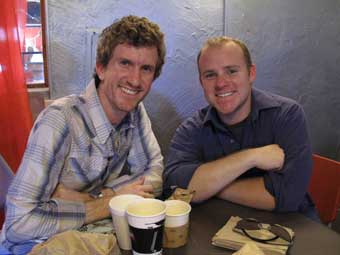 |
|
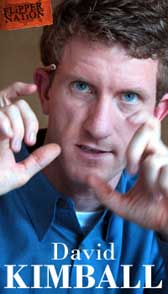 |
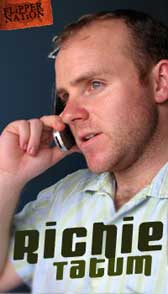 |
FlipperNation is about 2 guys who are trying to make it rich by flipping houses. The episodes show their misadventures at flipping their first house and all the strange people they deal with around house flipping like other realtors and contractors. It’s really great stuff and I can’t wait for the next episode.
What was really interesting about my meeting with them was that it got me thinking about the state of video content today in the world of the Internet, interactivity, and declining TV viewership. As I wrote my first email to them, giving them some feedback on what could make their internet video show better, I thought about the ways that some video outfits were getting really creative at leveraging the Internet and interactivity to engage the viewership in ways that was not possible in the days before the Internet.
Passive TV consumption is waning. Users are getting more sophisticated and want something that involves and communicates with them rather than sitting there like drones and just receiving.
My first encounter with interactivity aligned with a TV show was way back around 1999 when “Who Wants to be a Millionaire?” was the big thing, and they rigged this Internet game that played along live with the TV show itself. You could play against other players who also played along, and winning gave you points which could land you on the main leaderboard. It was incredibly well orchestrated, and it must have been a nightmare to manage as it needed to coordinate with the current live showing in 4 time zones.
Another example of using the Internet is with Sci-Fi Channel’s Battlestar Galactica where, between seasons, they shot a whole series of shorts that connected the last episode of the previous season with the new upcoming season, and showed them on their website. It was a way to inexpensively engage viewers while the new season was being prepared, but yet keep them interested and wanting more as the story line unfolded. Also on the website are podcasts, additional commentary, images, interviews with the stars – Sci-fi Channel did a great job of filling out the blanks for curious fans to consume, whereas in pre-Internet days this information was impossible to see.
FlipperNation already had employed some of these types of ideas. They have employed guerilla marketing such as getting on MySpace and each character has a page as well. Their website includes a whole bunch of content related to real estate and the art of flipping houses. They have an email address where you can submit your house to be on the next episode of FlipperNation. We brainstormed on many more ideas at our meeting yesterday, extending on the usage of the Internet, engaging the viewership and keeping them humorously hooked.
I think FlipperNation has legs. They are now looking to sign up with a studio and go big. I will be watching them and hope one day I can say, “I knew those guys when they were nobodys, and now they’re somebody!” That’s show biz!
The Amazing Pace of Change at My Alma Mater, Yahoo!
I just found the email that detailed the re-org at Yahoo! from Sue Decker, head of the new Advertiser & Publisher Group. It’s posted at Techcrunch:
Text of Email to all Yahoos, Techcrunch
I have been out of Yahoo! since Sept 2004, and in 2+ short years, I see:
* Lots of EVPs and SVPs. They used to make you run the gauntlet before making even VP.
* I only recognize about 6 names in the email out of about 15. The influx of new people is staggering at the higher levels. Where did all the people I knew go?
* The company is organizing in a very “large company” way. The changes were in the making while I was still there, but now they are extended more.
* Valleywag’s post about slightly less kneeling before Zod is a bit cutting, but it does make a point. I am not sure that splitting engineering (and by the way I heard through the grapevine that my old user experience group is reporting into the product teams now too) is going to be good for the company in the long term.
To me, companies always undergo cycles; they try things, they work or don’t work, and then they go back to try old things, and then they work/don’t work, and then you’re back to trying stuff you tried before. I suppose it’s one way to keep the world off balance to distract you from other possible issues with the company.
VoxPop Goes Live with Oscars Game, Yankees Decade of Dominance
One of the coolest things I’ve seen is when one of my startups gets their first site or application up and running. VoxPop has been busting their butts getting their first two promotions up:
EW.com Presents the 79th Annual Academy Awards: Pick the Winners
WCBS Newsradio 880 Presents the Yankees Decade of Dominance Tournament
Incredibly well done and designed. Their contest engine is working nicely and the front end design is beautiful. Check them out and enjoy!
Learn more about VoxPop on their site…
The Power of Referrals
Just recently, I’ve been thinking more and more about the power of referrals as applied on to Internet businesses.
Think about Digg.com. I “digg” an news article, so I hit the “digg” button and it gets tossed onto the Digg.com list. Because I “digg” it, I am essentially referring it those who subscribe to the Digg feed of news articles. In aggregation with the crowd’s opinions, as well as with some newly discovered editorial color on top of it, my referral could get sent to the those who like the Digg referral style of consuming news, as a way of uncovering interesting news.
On NYTimes.com, I just learned that they consider the number of times a story is emailed a better measure of popularity than just the number of clicks to read a story. If you think about it, calculating most popular based on clicks can have a self-fulfilling prophecy aspect to it; those on the most popular list are seen by more users who click on them more, and those stories inevitably stay on the most popular lists longer than they should. But, if you think the number of times a story is emailed, then you realize that if someone were to think this story is great, then they’re going to refer it to friends. It’s an added metric on top of how many times the story is read and helps fine tune out of self-fulfilling prophecies.
A new site I was just introduced to works on the same referral principle: downfly.com. It is a simple application which allows you to post a link on the site and it gets “passed” to your social network. Every now and then, I’ll get an email from the system that sends me links that get passed to me. As I use it more, I find it to be entertaining, a great way to discover new sites, and I also get to see what people in my network are thinking about and consider important enough to pass down their social network chain. But as I become a “passer” of links, I can’t help but think about what I’m passing and why and the ramifications of passing. I want to pass good links, not junk. I don’t want to waste peoples’ time by passing stupid links. I think about the value they’re going to get and make sure they get some from whatever site/link I’m passing them. I also can’t help but think about what they think of me as they’re receiving my link passes. That would be something interesting to implement is a feedback system that allows people to easily comment or feedback on the stuff they’re getting, as a mechanism to see if I’m doing a good job or not.
I see this referral aspect also in my advising/investing business. I see part of my job eventually is to help my early stage companies raise funding. I also see part of my job is to utilize my network to bring them valuable business partnership opportunities. But I told myself long ago that I need to build trust in my referrals to these folks. Investors don’t want to keep seeing junk from you; they’ll never take your call if you keep wasting their time with lame businesses. Potential business partners don’t want to see junk either. I think deeply about whether there is true value in a partnership with someone before I introduce them. I don’t want to make frivolous introductions, again because I want to continue building trust in my network that when I refer somebody to them, that I’m not doing that randomly, and that 10 times out of 10 it will be something they should look at.
Look at the effects of referral:
1. You the referrer have a desire to bring value to the receivers of the referrals. This altruistic notion forms the basis of the positive effects and power of referrals.
2. You think heavily on what could be interesting or valuable to them, so you’re careful at referring things to them. Thus, you as a referrer need to get to know your receivers at some level to know what could be interesting to them. If you don’t know them well, your referrals could have a negative effect on you as the referrer as your referrals could be perceived as random or junk. They may ask you to stop. Refer effectively by getting to know your receivers.
3. Successful or valuable referring can have positive effects on your reputation. It builds trust in your receivers of the referrals that you are giving them something valuable. It also builds trust in the thing you’re referring, like a website, or business opportunity, or news story. It was checked out by the referrer, whom you trust, and thus you have a tendency to trust it more too.
4. If they like your referrals, you may get value back, in the form of good referrals or otherwise. If there is some measure of how good a referrer you are, like a ratings system, you can gain in reputation in a visible way. That rating is value to referrer, as is other things.
5. Referrals can be a better measure of popularity and “this is valuable or good” based on all of the above, and helps remove self-fulfilling prophecy effects of other forms of popularity measures.
6. You refer poorly, or annoyingly, and people will shut you off. Trust is lost, and thus reputation is lowered. And also they will lose trust in the thing you refer. As an entrepreneur, make sure you get referred by someone who is trustworthy as a referrer, and not somebody who has low or potentially low trust amongst the people you’re trying to get referred to. This can be very hard to determine who is trustworthy as a referrer and who is not, so tread carefully.
7. The system which enables referring effectively can use this as a viral marketing tool to gain more customers or users.
As I think on the effects of referral, I am going to try to employ it more often in thinking on product strategy with my companies.
Teaching and Learning Responsibility and Consequences in the Age of the Internet
Today, the headlines wrote that Miss Nevada in the Miss America competition would be replaced by another, on the revealing of exposed breast pictures and other ‘deemed inappropriate’ acts several years ago as a teenager. Apparently, a friend had taken those shots and then posted them on the Internet. Consequently, they were discovered and Miss Nevada was disqualified and the honor given to the next in line. She is realizing firsthand the dangers of actions which happened years ago coupled with the openness of the Web.
The Internet has become a place for free expression but fraught with unexpected consequences for those we express without restraint or forethought. We are in a transitional generation learning with trial by fire (or error) and missteps on what the Internet can do and what dangers it can represent.
Prior to the Internet, our society’s private information was very much protected by the lack of technology and by physical barriers. We never had to worry about people seeing our pictures because they just sat in old shoe boxes or albums and nobody could see them except those whom you wanted to. Our personal information was our own; what we did in our bedrooms, closets, and homes never had webcams focused on them or digital phone cams to send to others.
With the emergence of sharing tools in technology and on the Internet, it was now possible to take all that information and put it out there, often times simply because someone asked for it, or because we thought it would be funny….for the moment. Somehow in our naviete we thought that we could put it out there, it would do its thing, making someone laugh, or be just a passing comment on a post or instant message, and then we forgot about it, thinking it be lost in the masses of information on the Web.
The Web sometimes loses things, but most of the time it does not disappear. Search engines make finding things easier. We all get googled now before we meet people just to see what we can learn about them before we meet them. Information is archived on sites because every page a site has means more page loads for ads to be shown on. It doesn’t make sense for Web companies to blow old information away. Text gets saved and copied, and re-pasted or quoted somewhere else. Pictures and videos are saved and re-posted. Even if you think your picture is deleted in one place, someone else may have saved it for their own use and it may re-emerge.
So now it’s not our own naviete but the responsibility of others both close to you and not. Even if you don’t post something, someone else could. Embarassing pictures taken at an office party get posted to your favorite blog; your drunken actions at a frat party re-emerge to make you lose a job offer years later. The news is filled with instances where everyone is getting googled and embarassing information surfaces about that person that pre-Internet would never have been found, like to the detriment of Miss Nevada.
Openness is good and to the extent we can find out more about the people around us is probably positive in the long run. But for us, in the transitional generation, we have not done well enough in teaching our youth or ourselves about the dangers of posting text, pictures, and video on to the Net and the future ramifications of doing so. We need to do better in knowing that we need to think more carefully before we act impetuously in hitting the enter key. And that sometimes, our actions not only affect ourselves but others as well.
My hope is that our educational resources will add materials about the positive and negative aspects of posting to the Internet as soon as possible to their curricula. And for us, who are out there with our school days behind us, I hope that we can just pause a moment before we hit that enter key and think on whether sending that file or post is really the right thing to do, even if it is funny in the moment.
Fame and Competition on the Net
It started way back in the middle of the Internet boom years. I got onto eBay and started bidding on toasters (I collect antique toasters…!) As I bought and sold stuff, I collected positive ratings for my transaction behavior. As my positive ratings grew, I became more obsessed with responding quickly and often about my transactions. If I was buying, I would send payment as soon as possible or notify the seller that I had a delay. Likewise for selling, I would make sure I respond quickly and let the buyer know exactly when to expect the item. My rating was my reputation on eBay and it became one of the most important things I would build on the Internet, which was a trust rating that I cherished and allowed me to do things on eBay with other members that untrusted, poorly rated members would not.
Around the same time, Who Wants to Be a Millionaire? became one of the hottest TV shows. But something that ABC did that not many knew about was the fact that you could play real time along with the show and compete against others also playing via the Internet. I also started playing along with the show and the designers of the Web game did some really great things like allow you to accumulate points upon answering questions successfully and in a timely fashion (more points for faster answering). Players with the most points were put up on a leaderboard which you strived for. It was amazing how many points some people had accumulated. It made you really try to get to the top of the leaderboard and feel….famous for being the best. And the world knew you were the best because the leaderboard was visible to all.
Fast forward to 2004 where I discovered that HotOrNot.com had put up the ability to send virtual flowers to people you liked and wanted to meet via its meeting service. But they did something clever. If you received virtual flowers, they would appear next to your picture. It gave you a sense of superiority; I’ve got 10 roses! How many do you have? It made you feel great about yourself and showed the world that others thought you were hot enough to send flowers to.
And now, as a frequent contributor to Yelp, I find myself racing to be the first reviewer of a restaurant. When you are, you get a little icon that states you are a first reviewer and then on your profile, it shows how many first reviews you’ve made. Then, I started writing witty reviews instead of boring ones. Because readers can rate reviews on the basis of Useful (big deal) or Cool (yeah!) or Funny (even better!). For some reason, I sought to write better reviews in an attempt to get more Cool and Funny ratings! It’s easy to write a Useful review, but not many can entertain or be noted for being “cool”.
Fame and competition go hand in hand on the Internet. It’s one of the best techniques for getting users continually engaged on your website. You hook them in by making them feel like they are the best at something, and let others know about it. If others can say your cool or the best, that’s even better because now you have validation from the crowd. How much validation do we get in real life, even from the people we know and love? Often times – ZIP. But on the Internet, the millions of surfers can come by and tag you as cool, or see that you’re the best at something.
Then since you know the crowd is watching, it makes you want to participate more, and it pushes you more to do better at whatever you’re participating in. It draws you in and the reward is fame and notoriety whereas in the real world you may not have that chance.
It’s easy to reward people with money. But it’s costly and you need money first before you can give it away. When the reward is not money, sometimes it’s more powerful at encouraging and reinforcing user engagement. I would argue that it is even more long lasting because if it’s some contest you’re in and you win, that’s where it usually ends. There is no more beyond that. With a well crafted fame and competition scheme, you can engage users for a much longer time and at much lower cost.
Working with my startups on developing fame and competition systems tailored for their services is something I think about all the time.